Examining Australia's National Health Priority Areas and Strategies
VerifiedAdded on 2022/10/01
|8
|2027
|14
Report
AI Summary
This report provides a detailed analysis of Australia's National Health Priority Areas (NHPA). It begins with an introduction to the concept of health priorities and their importance in resource allocation and policy-making. The report then identifies the specific NHPA in Australia, including cardiovascular disease, cancer, mental health, injury prevention and control, diabetes mellitus, asthma, and obesity. Each area is examined in terms of prevalence, mortality rates, and the government initiatives and health promotion strategies implemented to address them. For instance, the report highlights the high prevalence of cardiovascular disease, the impact of cancer on the aging population, and the initiatives aimed at managing mental health disorders. It also discusses the strategies for injury prevention, the increasing rates of diabetes, and the efforts to control asthma and obesity. The report concludes by emphasizing the significance of having health priority areas to effectively manage diseases and allocate resources. It also highlights the role of research and ethical use of medical technology in informed decision-making. The report references various sources to support its findings.
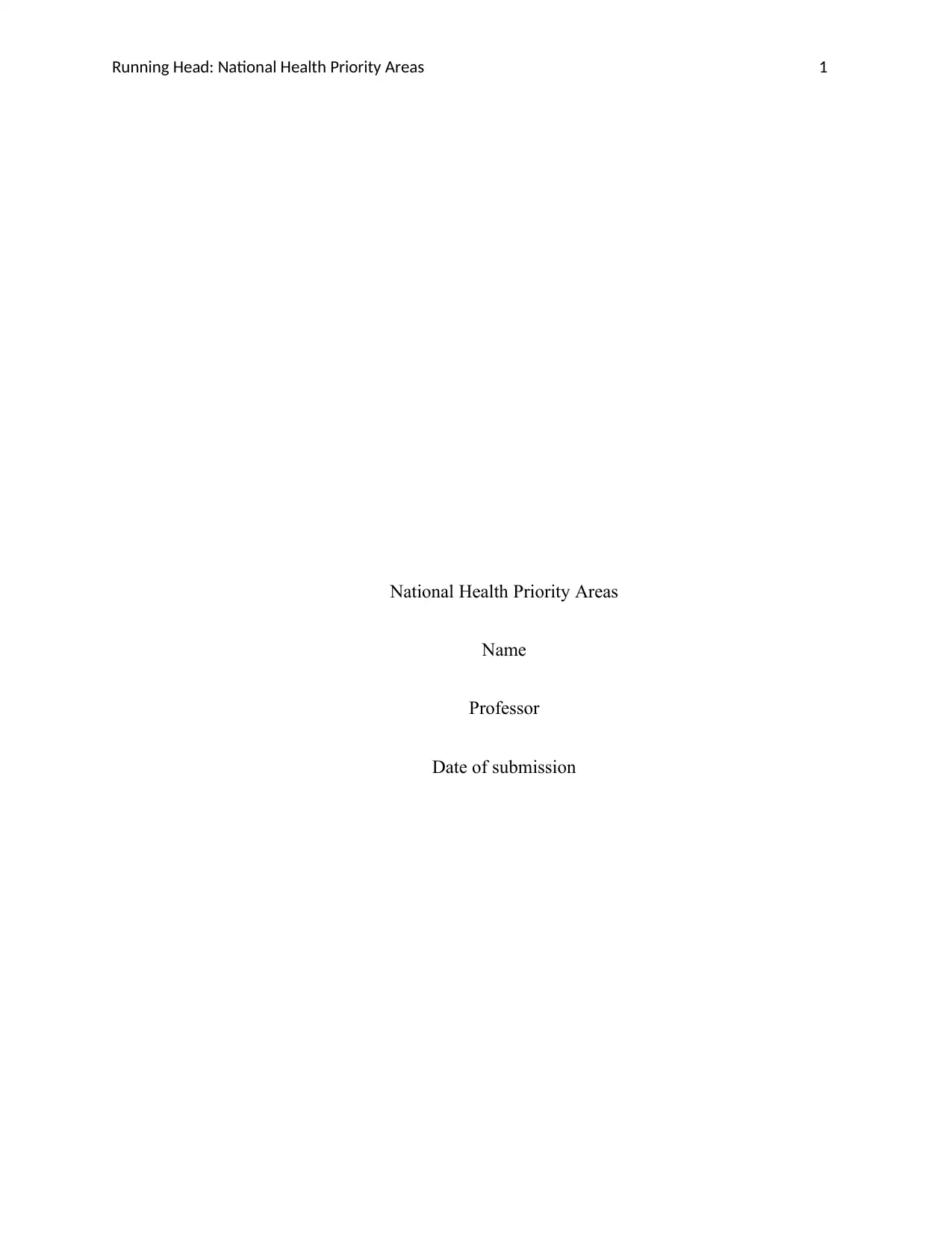
Running Head: National Health Priority Areas 1
National Health Priority Areas
Name
Professor
Date of submission
National Health Priority Areas
Name
Professor
Date of submission
Paraphrase This Document
Need a fresh take? Get an instant paraphrase of this document with our AI Paraphraser
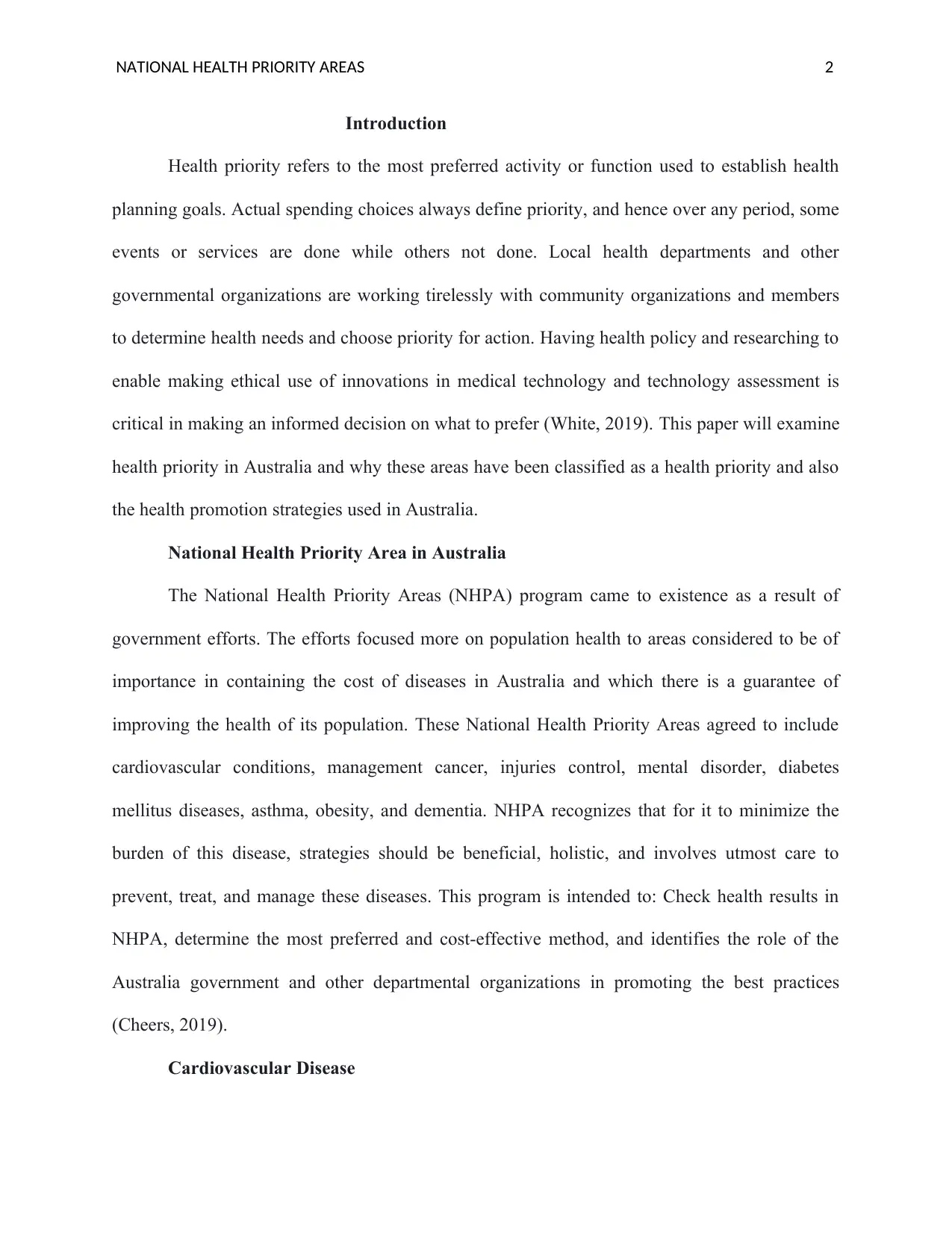
NATIONAL HEALTH PRIORITY AREAS 2
Introduction
Health priority refers to the most preferred activity or function used to establish health
planning goals. Actual spending choices always define priority, and hence over any period, some
events or services are done while others not done. Local health departments and other
governmental organizations are working tirelessly with community organizations and members
to determine health needs and choose priority for action. Having health policy and researching to
enable making ethical use of innovations in medical technology and technology assessment is
critical in making an informed decision on what to prefer (White, 2019). This paper will examine
health priority in Australia and why these areas have been classified as a health priority and also
the health promotion strategies used in Australia.
National Health Priority Area in Australia
The National Health Priority Areas (NHPA) program came to existence as a result of
government efforts. The efforts focused more on population health to areas considered to be of
importance in containing the cost of diseases in Australia and which there is a guarantee of
improving the health of its population. These National Health Priority Areas agreed to include
cardiovascular conditions, management cancer, injuries control, mental disorder, diabetes
mellitus diseases, asthma, obesity, and dementia. NHPA recognizes that for it to minimize the
burden of this disease, strategies should be beneficial, holistic, and involves utmost care to
prevent, treat, and manage these diseases. This program is intended to: Check health results in
NHPA, determine the most preferred and cost-effective method, and identifies the role of the
Australia government and other departmental organizations in promoting the best practices
(Cheers, 2019).
Cardiovascular Disease
Introduction
Health priority refers to the most preferred activity or function used to establish health
planning goals. Actual spending choices always define priority, and hence over any period, some
events or services are done while others not done. Local health departments and other
governmental organizations are working tirelessly with community organizations and members
to determine health needs and choose priority for action. Having health policy and researching to
enable making ethical use of innovations in medical technology and technology assessment is
critical in making an informed decision on what to prefer (White, 2019). This paper will examine
health priority in Australia and why these areas have been classified as a health priority and also
the health promotion strategies used in Australia.
National Health Priority Area in Australia
The National Health Priority Areas (NHPA) program came to existence as a result of
government efforts. The efforts focused more on population health to areas considered to be of
importance in containing the cost of diseases in Australia and which there is a guarantee of
improving the health of its population. These National Health Priority Areas agreed to include
cardiovascular conditions, management cancer, injuries control, mental disorder, diabetes
mellitus diseases, asthma, obesity, and dementia. NHPA recognizes that for it to minimize the
burden of this disease, strategies should be beneficial, holistic, and involves utmost care to
prevent, treat, and manage these diseases. This program is intended to: Check health results in
NHPA, determine the most preferred and cost-effective method, and identifies the role of the
Australia government and other departmental organizations in promoting the best practices
(Cheers, 2019).
Cardiovascular Disease
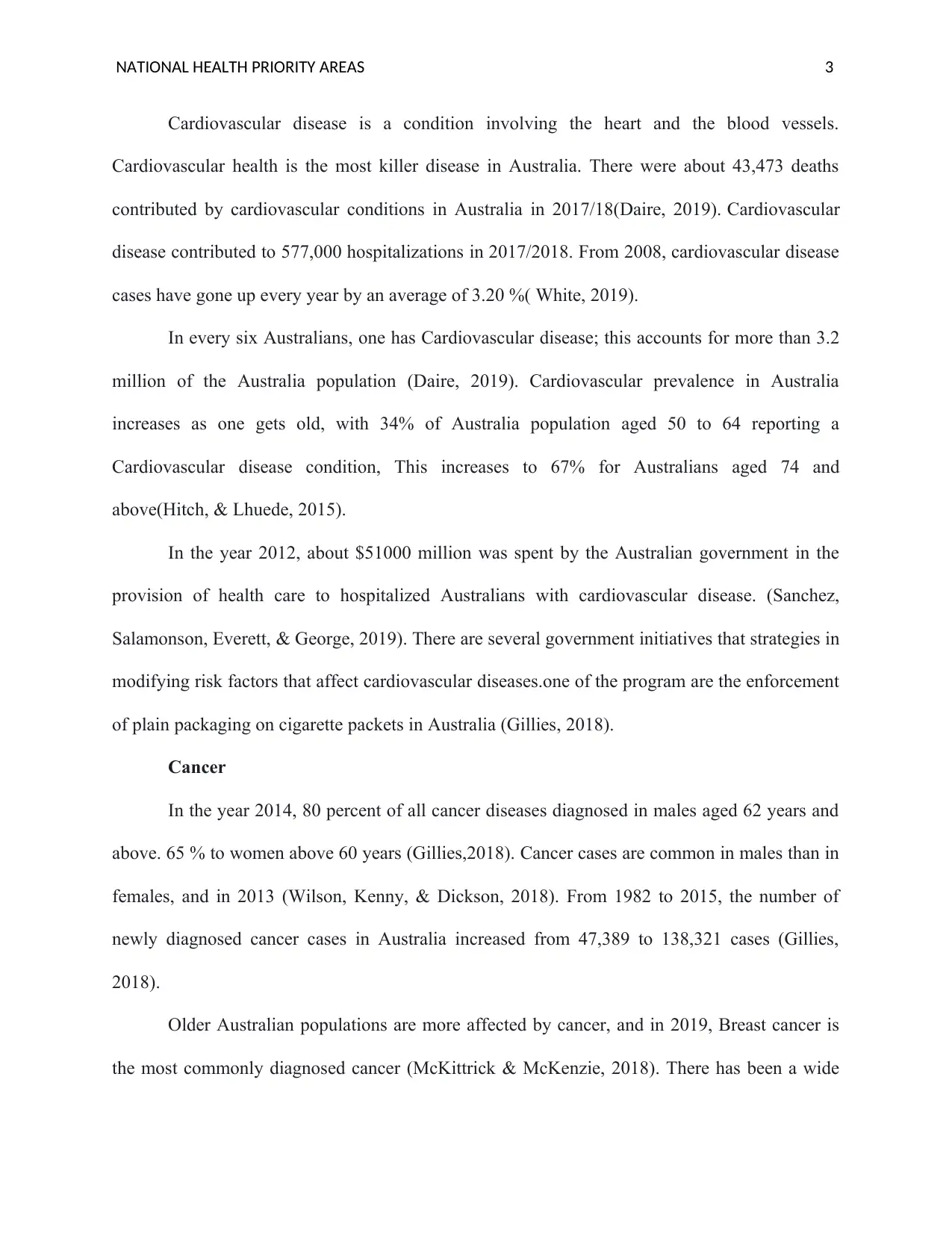
NATIONAL HEALTH PRIORITY AREAS 3
Cardiovascular disease is a condition involving the heart and the blood vessels.
Cardiovascular health is the most killer disease in Australia. There were about 43,473 deaths
contributed by cardiovascular conditions in Australia in 2017/18(Daire, 2019). Cardiovascular
disease contributed to 577,000 hospitalizations in 2017/2018. From 2008, cardiovascular disease
cases have gone up every year by an average of 3.20 %( White, 2019).
In every six Australians, one has Cardiovascular disease; this accounts for more than 3.2
million of the Australia population (Daire, 2019). Cardiovascular prevalence in Australia
increases as one gets old, with 34% of Australia population aged 50 to 64 reporting a
Cardiovascular disease condition, This increases to 67% for Australians aged 74 and
above(Hitch, & Lhuede, 2015).
In the year 2012, about $51000 million was spent by the Australian government in the
provision of health care to hospitalized Australians with cardiovascular disease. (Sanchez,
Salamonson, Everett, & George, 2019). There are several government initiatives that strategies in
modifying risk factors that affect cardiovascular diseases.one of the program are the enforcement
of plain packaging on cigarette packets in Australia (Gillies, 2018).
Cancer
In the year 2014, 80 percent of all cancer diseases diagnosed in males aged 62 years and
above. 65 % to women above 60 years (Gillies,2018). Cancer cases are common in males than in
females, and in 2013 (Wilson, Kenny, & Dickson, 2018). From 1982 to 2015, the number of
newly diagnosed cancer cases in Australia increased from 47,389 to 138,321 cases (Gillies,
2018).
Older Australian populations are more affected by cancer, and in 2019, Breast cancer is
the most commonly diagnosed cancer (McKittrick & McKenzie, 2018). There has been a wide
Cardiovascular disease is a condition involving the heart and the blood vessels.
Cardiovascular health is the most killer disease in Australia. There were about 43,473 deaths
contributed by cardiovascular conditions in Australia in 2017/18(Daire, 2019). Cardiovascular
disease contributed to 577,000 hospitalizations in 2017/2018. From 2008, cardiovascular disease
cases have gone up every year by an average of 3.20 %( White, 2019).
In every six Australians, one has Cardiovascular disease; this accounts for more than 3.2
million of the Australia population (Daire, 2019). Cardiovascular prevalence in Australia
increases as one gets old, with 34% of Australia population aged 50 to 64 reporting a
Cardiovascular disease condition, This increases to 67% for Australians aged 74 and
above(Hitch, & Lhuede, 2015).
In the year 2012, about $51000 million was spent by the Australian government in the
provision of health care to hospitalized Australians with cardiovascular disease. (Sanchez,
Salamonson, Everett, & George, 2019). There are several government initiatives that strategies in
modifying risk factors that affect cardiovascular diseases.one of the program are the enforcement
of plain packaging on cigarette packets in Australia (Gillies, 2018).
Cancer
In the year 2014, 80 percent of all cancer diseases diagnosed in males aged 62 years and
above. 65 % to women above 60 years (Gillies,2018). Cancer cases are common in males than in
females, and in 2013 (Wilson, Kenny, & Dickson, 2018). From 1982 to 2015, the number of
newly diagnosed cancer cases in Australia increased from 47,389 to 138,321 cases (Gillies,
2018).
Older Australian populations are more affected by cancer, and in 2019, Breast cancer is
the most commonly diagnosed cancer (McKittrick & McKenzie, 2018). There has been a wide
⊘ This is a preview!⊘
Do you want full access?
Subscribe today to unlock all pages.

Trusted by 1+ million students worldwide
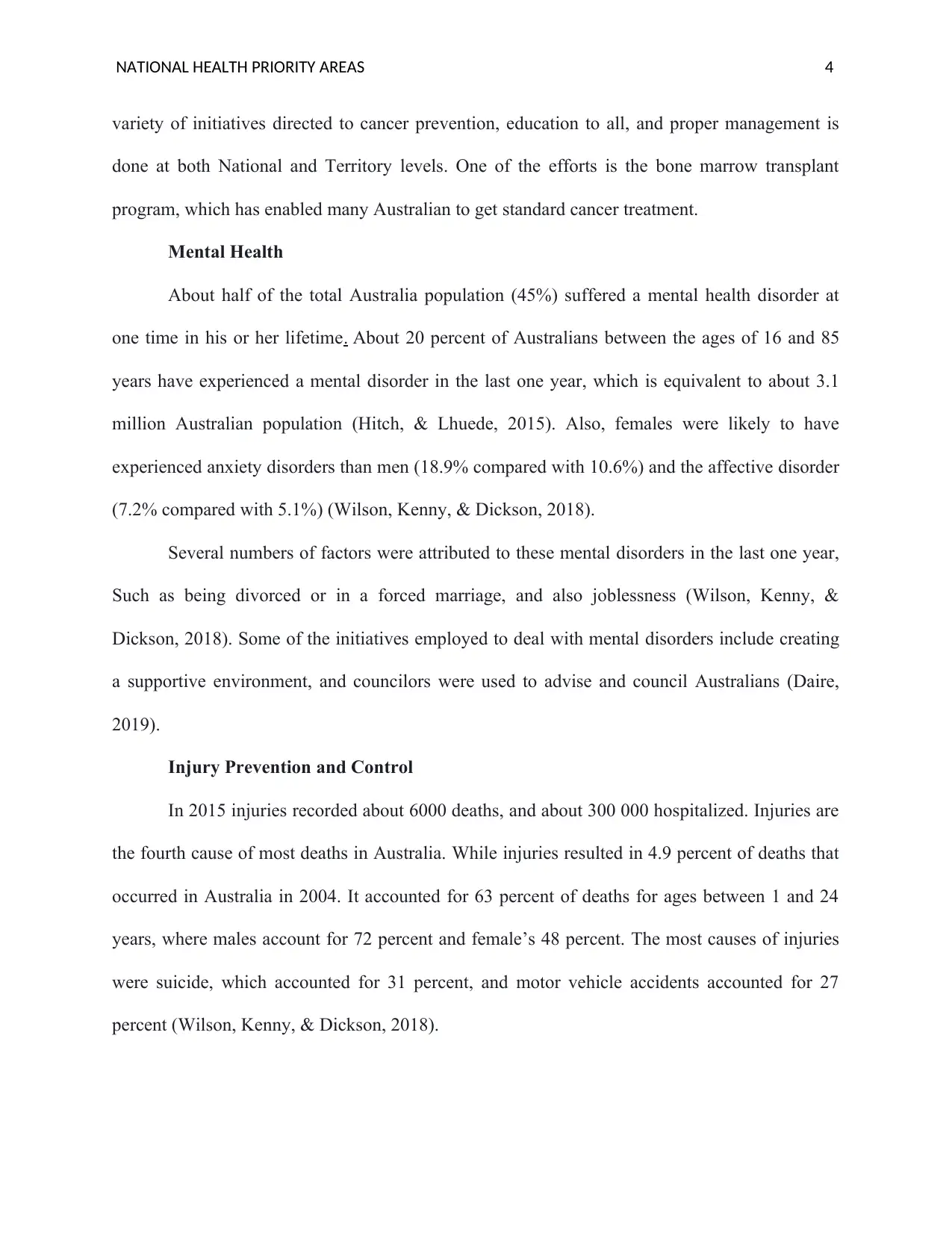
NATIONAL HEALTH PRIORITY AREAS 4
variety of initiatives directed to cancer prevention, education to all, and proper management is
done at both National and Territory levels. One of the efforts is the bone marrow transplant
program, which has enabled many Australian to get standard cancer treatment.
Mental Health
About half of the total Australia population (45%) suffered a mental health disorder at
one time in his or her lifetime. About 20 percent of Australians between the ages of 16 and 85
years have experienced a mental disorder in the last one year, which is equivalent to about 3.1
million Australian population (Hitch, & Lhuede, 2015). Also, females were likely to have
experienced anxiety disorders than men (18.9% compared with 10.6%) and the affective disorder
(7.2% compared with 5.1%) (Wilson, Kenny, & Dickson, 2018).
Several numbers of factors were attributed to these mental disorders in the last one year,
Such as being divorced or in a forced marriage, and also joblessness (Wilson, Kenny, &
Dickson, 2018). Some of the initiatives employed to deal with mental disorders include creating
a supportive environment, and councilors were used to advise and council Australians (Daire,
2019).
Injury Prevention and Control
In 2015 injuries recorded about 6000 deaths, and about 300 000 hospitalized. Injuries are
the fourth cause of most deaths in Australia. While injuries resulted in 4.9 percent of deaths that
occurred in Australia in 2004. It accounted for 63 percent of deaths for ages between 1 and 24
years, where males account for 72 percent and female’s 48 percent. The most causes of injuries
were suicide, which accounted for 31 percent, and motor vehicle accidents accounted for 27
percent (Wilson, Kenny, & Dickson, 2018).
variety of initiatives directed to cancer prevention, education to all, and proper management is
done at both National and Territory levels. One of the efforts is the bone marrow transplant
program, which has enabled many Australian to get standard cancer treatment.
Mental Health
About half of the total Australia population (45%) suffered a mental health disorder at
one time in his or her lifetime. About 20 percent of Australians between the ages of 16 and 85
years have experienced a mental disorder in the last one year, which is equivalent to about 3.1
million Australian population (Hitch, & Lhuede, 2015). Also, females were likely to have
experienced anxiety disorders than men (18.9% compared with 10.6%) and the affective disorder
(7.2% compared with 5.1%) (Wilson, Kenny, & Dickson, 2018).
Several numbers of factors were attributed to these mental disorders in the last one year,
Such as being divorced or in a forced marriage, and also joblessness (Wilson, Kenny, &
Dickson, 2018). Some of the initiatives employed to deal with mental disorders include creating
a supportive environment, and councilors were used to advise and council Australians (Daire,
2019).
Injury Prevention and Control
In 2015 injuries recorded about 6000 deaths, and about 300 000 hospitalized. Injuries are
the fourth cause of most deaths in Australia. While injuries resulted in 4.9 percent of deaths that
occurred in Australia in 2004. It accounted for 63 percent of deaths for ages between 1 and 24
years, where males account for 72 percent and female’s 48 percent. The most causes of injuries
were suicide, which accounted for 31 percent, and motor vehicle accidents accounted for 27
percent (Wilson, Kenny, & Dickson, 2018).
Paraphrase This Document
Need a fresh take? Get an instant paraphrase of this document with our AI Paraphraser
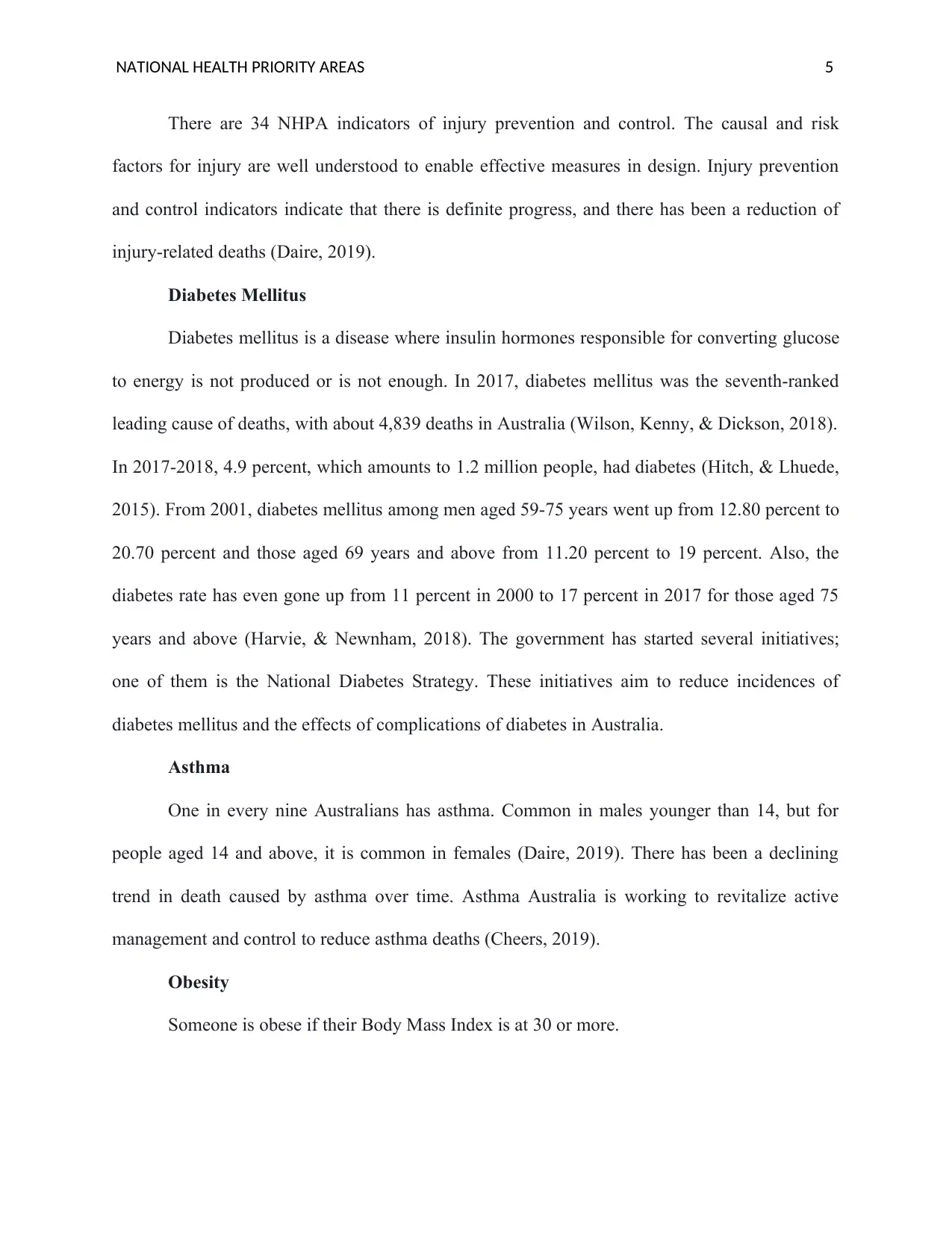
NATIONAL HEALTH PRIORITY AREAS 5
There are 34 NHPA indicators of injury prevention and control. The causal and risk
factors for injury are well understood to enable effective measures in design. Injury prevention
and control indicators indicate that there is definite progress, and there has been a reduction of
injury-related deaths (Daire, 2019).
Diabetes Mellitus
Diabetes mellitus is a disease where insulin hormones responsible for converting glucose
to energy is not produced or is not enough. In 2017, diabetes mellitus was the seventh-ranked
leading cause of deaths, with about 4,839 deaths in Australia (Wilson, Kenny, & Dickson, 2018).
In 2017-2018, 4.9 percent, which amounts to 1.2 million people, had diabetes (Hitch, & Lhuede,
2015). From 2001, diabetes mellitus among men aged 59-75 years went up from 12.80 percent to
20.70 percent and those aged 69 years and above from 11.20 percent to 19 percent. Also, the
diabetes rate has even gone up from 11 percent in 2000 to 17 percent in 2017 for those aged 75
years and above (Harvie, & Newnham, 2018). The government has started several initiatives;
one of them is the National Diabetes Strategy. These initiatives aim to reduce incidences of
diabetes mellitus and the effects of complications of diabetes in Australia.
Asthma
One in every nine Australians has asthma. Common in males younger than 14, but for
people aged 14 and above, it is common in females (Daire, 2019). There has been a declining
trend in death caused by asthma over time. Asthma Australia is working to revitalize active
management and control to reduce asthma deaths (Cheers, 2019).
Obesity
Someone is obese if their Body Mass Index is at 30 or more.
There are 34 NHPA indicators of injury prevention and control. The causal and risk
factors for injury are well understood to enable effective measures in design. Injury prevention
and control indicators indicate that there is definite progress, and there has been a reduction of
injury-related deaths (Daire, 2019).
Diabetes Mellitus
Diabetes mellitus is a disease where insulin hormones responsible for converting glucose
to energy is not produced or is not enough. In 2017, diabetes mellitus was the seventh-ranked
leading cause of deaths, with about 4,839 deaths in Australia (Wilson, Kenny, & Dickson, 2018).
In 2017-2018, 4.9 percent, which amounts to 1.2 million people, had diabetes (Hitch, & Lhuede,
2015). From 2001, diabetes mellitus among men aged 59-75 years went up from 12.80 percent to
20.70 percent and those aged 69 years and above from 11.20 percent to 19 percent. Also, the
diabetes rate has even gone up from 11 percent in 2000 to 17 percent in 2017 for those aged 75
years and above (Harvie, & Newnham, 2018). The government has started several initiatives;
one of them is the National Diabetes Strategy. These initiatives aim to reduce incidences of
diabetes mellitus and the effects of complications of diabetes in Australia.
Asthma
One in every nine Australians has asthma. Common in males younger than 14, but for
people aged 14 and above, it is common in females (Daire, 2019). There has been a declining
trend in death caused by asthma over time. Asthma Australia is working to revitalize active
management and control to reduce asthma deaths (Cheers, 2019).
Obesity
Someone is obese if their Body Mass Index is at 30 or more.
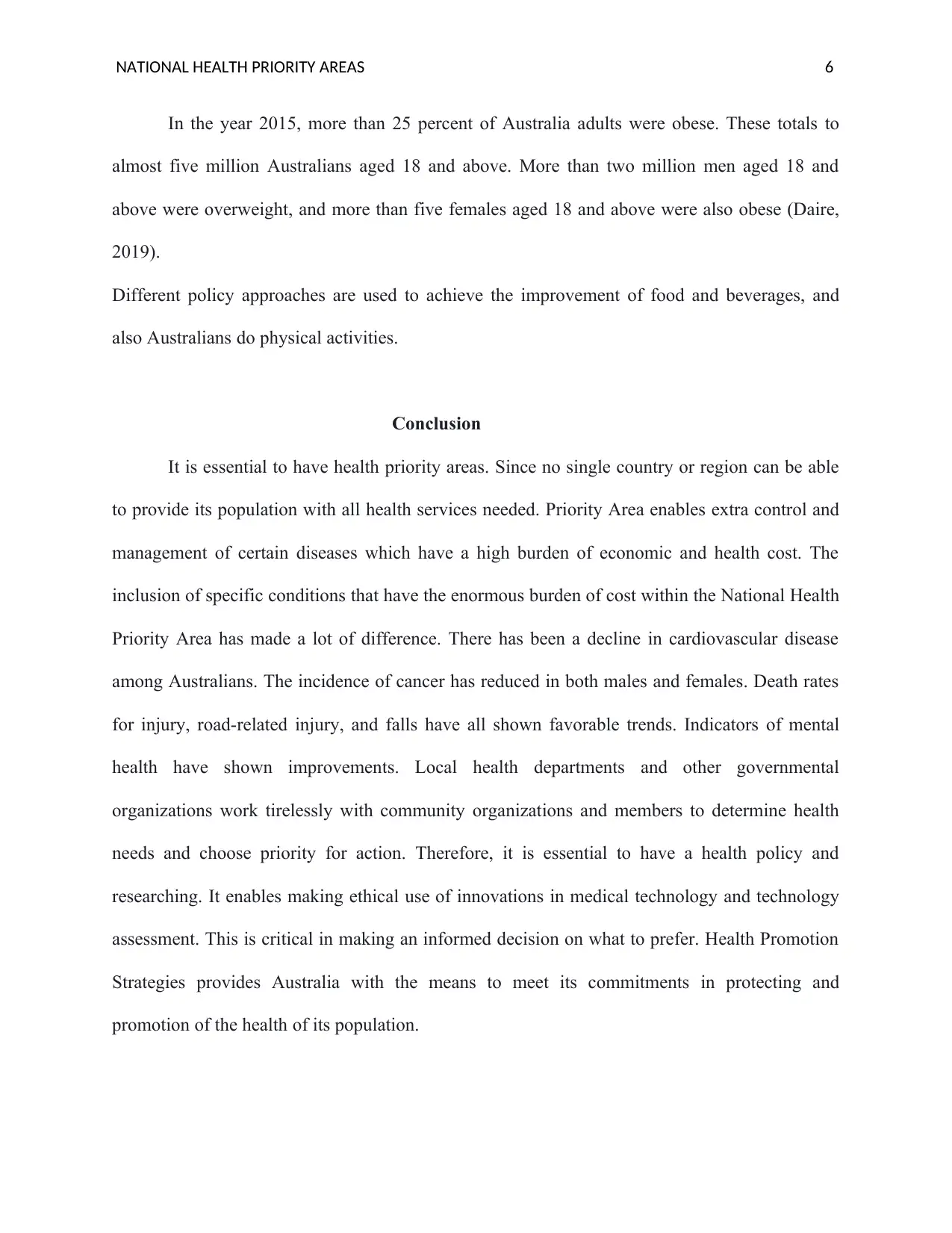
NATIONAL HEALTH PRIORITY AREAS 6
In the year 2015, more than 25 percent of Australia adults were obese. These totals to
almost five million Australians aged 18 and above. More than two million men aged 18 and
above were overweight, and more than five females aged 18 and above were also obese (Daire,
2019).
Different policy approaches are used to achieve the improvement of food and beverages, and
also Australians do physical activities.
Conclusion
It is essential to have health priority areas. Since no single country or region can be able
to provide its population with all health services needed. Priority Area enables extra control and
management of certain diseases which have a high burden of economic and health cost. The
inclusion of specific conditions that have the enormous burden of cost within the National Health
Priority Area has made a lot of difference. There has been a decline in cardiovascular disease
among Australians. The incidence of cancer has reduced in both males and females. Death rates
for injury, road-related injury, and falls have all shown favorable trends. Indicators of mental
health have shown improvements. Local health departments and other governmental
organizations work tirelessly with community organizations and members to determine health
needs and choose priority for action. Therefore, it is essential to have a health policy and
researching. It enables making ethical use of innovations in medical technology and technology
assessment. This is critical in making an informed decision on what to prefer. Health Promotion
Strategies provides Australia with the means to meet its commitments in protecting and
promotion of the health of its population.
In the year 2015, more than 25 percent of Australia adults were obese. These totals to
almost five million Australians aged 18 and above. More than two million men aged 18 and
above were overweight, and more than five females aged 18 and above were also obese (Daire,
2019).
Different policy approaches are used to achieve the improvement of food and beverages, and
also Australians do physical activities.
Conclusion
It is essential to have health priority areas. Since no single country or region can be able
to provide its population with all health services needed. Priority Area enables extra control and
management of certain diseases which have a high burden of economic and health cost. The
inclusion of specific conditions that have the enormous burden of cost within the National Health
Priority Area has made a lot of difference. There has been a decline in cardiovascular disease
among Australians. The incidence of cancer has reduced in both males and females. Death rates
for injury, road-related injury, and falls have all shown favorable trends. Indicators of mental
health have shown improvements. Local health departments and other governmental
organizations work tirelessly with community organizations and members to determine health
needs and choose priority for action. Therefore, it is essential to have a health policy and
researching. It enables making ethical use of innovations in medical technology and technology
assessment. This is critical in making an informed decision on what to prefer. Health Promotion
Strategies provides Australia with the means to meet its commitments in protecting and
promotion of the health of its population.
⊘ This is a preview!⊘
Do you want full access?
Subscribe today to unlock all pages.

Trusted by 1+ million students worldwide
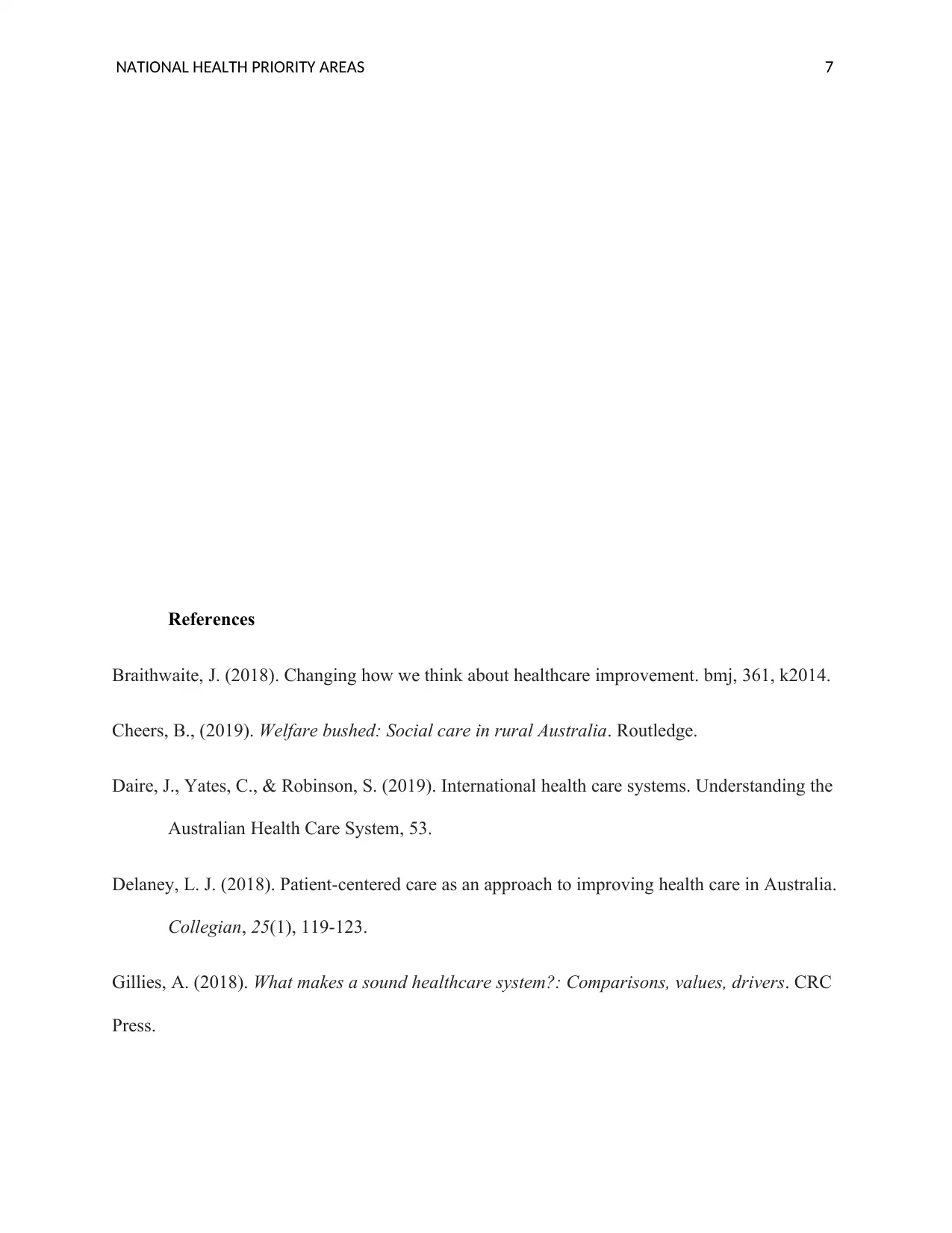
NATIONAL HEALTH PRIORITY AREAS 7
References
Braithwaite, J. (2018). Changing how we think about healthcare improvement. bmj, 361, k2014.
Cheers, B., (2019). Welfare bushed: Social care in rural Australia. Routledge.
Daire, J., Yates, C., & Robinson, S. (2019). International health care systems. Understanding the
Australian Health Care System, 53.
Delaney, L. J. (2018). Patient-centered care as an approach to improving health care in Australia.
Collegian, 25(1), 119-123.
Gillies, A. (2018). What makes a sound healthcare system?: Comparisons, values, drivers. CRC
Press.
References
Braithwaite, J. (2018). Changing how we think about healthcare improvement. bmj, 361, k2014.
Cheers, B., (2019). Welfare bushed: Social care in rural Australia. Routledge.
Daire, J., Yates, C., & Robinson, S. (2019). International health care systems. Understanding the
Australian Health Care System, 53.
Delaney, L. J. (2018). Patient-centered care as an approach to improving health care in Australia.
Collegian, 25(1), 119-123.
Gillies, A. (2018). What makes a sound healthcare system?: Comparisons, values, drivers. CRC
Press.
Paraphrase This Document
Need a fresh take? Get an instant paraphrase of this document with our AI Paraphraser
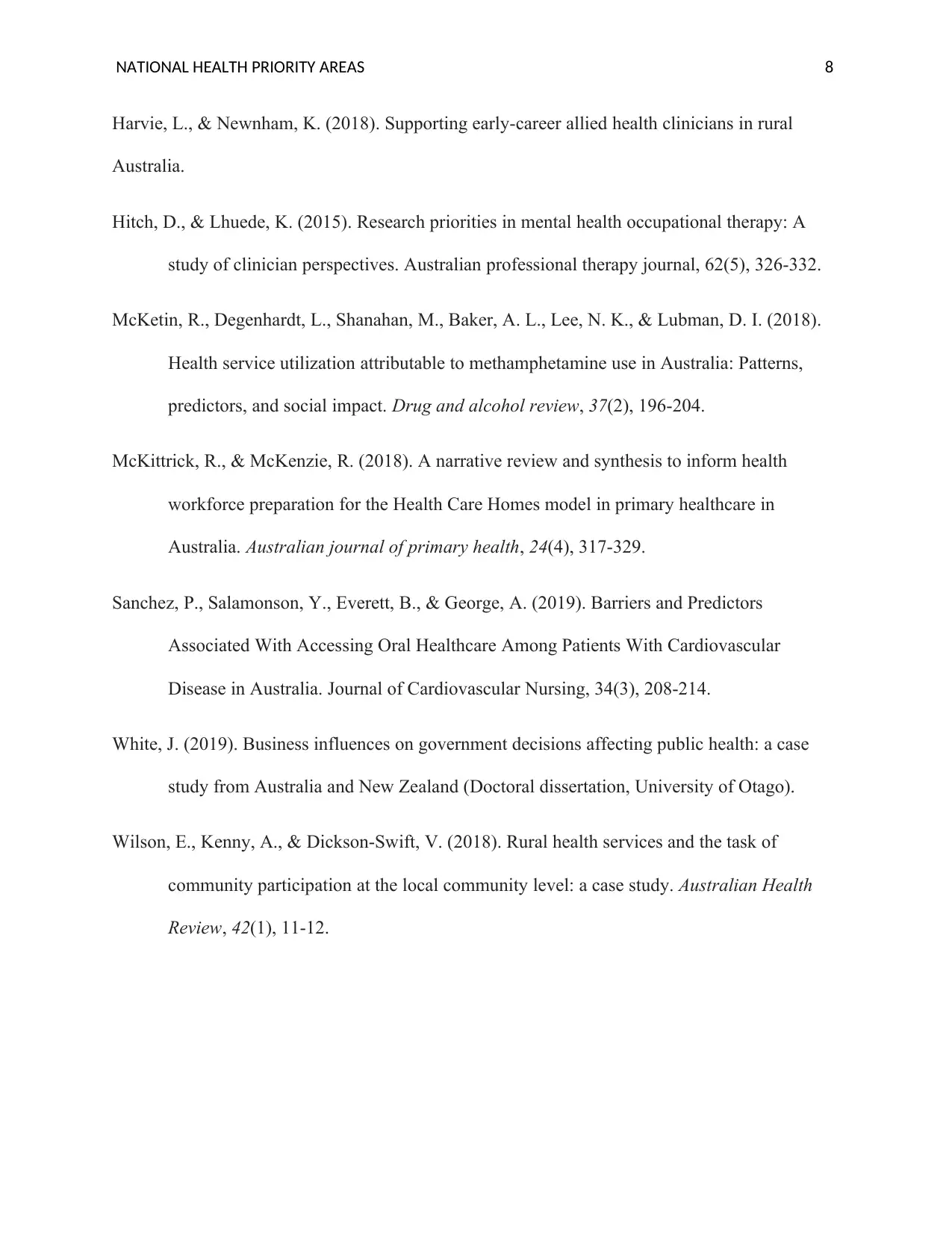
NATIONAL HEALTH PRIORITY AREAS 8
Harvie, L., & Newnham, K. (2018). Supporting early-career allied health clinicians in rural
Australia.
Hitch, D., & Lhuede, K. (2015). Research priorities in mental health occupational therapy: A
study of clinician perspectives. Australian professional therapy journal, 62(5), 326-332.
McKetin, R., Degenhardt, L., Shanahan, M., Baker, A. L., Lee, N. K., & Lubman, D. I. (2018).
Health service utilization attributable to methamphetamine use in Australia: Patterns,
predictors, and social impact. Drug and alcohol review, 37(2), 196-204.
McKittrick, R., & McKenzie, R. (2018). A narrative review and synthesis to inform health
workforce preparation for the Health Care Homes model in primary healthcare in
Australia. Australian journal of primary health, 24(4), 317-329.
Sanchez, P., Salamonson, Y., Everett, B., & George, A. (2019). Barriers and Predictors
Associated With Accessing Oral Healthcare Among Patients With Cardiovascular
Disease in Australia. Journal of Cardiovascular Nursing, 34(3), 208-214.
White, J. (2019). Business influences on government decisions affecting public health: a case
study from Australia and New Zealand (Doctoral dissertation, University of Otago).
Wilson, E., Kenny, A., & Dickson-Swift, V. (2018). Rural health services and the task of
community participation at the local community level: a case study. Australian Health
Review, 42(1), 11-12.
Harvie, L., & Newnham, K. (2018). Supporting early-career allied health clinicians in rural
Australia.
Hitch, D., & Lhuede, K. (2015). Research priorities in mental health occupational therapy: A
study of clinician perspectives. Australian professional therapy journal, 62(5), 326-332.
McKetin, R., Degenhardt, L., Shanahan, M., Baker, A. L., Lee, N. K., & Lubman, D. I. (2018).
Health service utilization attributable to methamphetamine use in Australia: Patterns,
predictors, and social impact. Drug and alcohol review, 37(2), 196-204.
McKittrick, R., & McKenzie, R. (2018). A narrative review and synthesis to inform health
workforce preparation for the Health Care Homes model in primary healthcare in
Australia. Australian journal of primary health, 24(4), 317-329.
Sanchez, P., Salamonson, Y., Everett, B., & George, A. (2019). Barriers and Predictors
Associated With Accessing Oral Healthcare Among Patients With Cardiovascular
Disease in Australia. Journal of Cardiovascular Nursing, 34(3), 208-214.
White, J. (2019). Business influences on government decisions affecting public health: a case
study from Australia and New Zealand (Doctoral dissertation, University of Otago).
Wilson, E., Kenny, A., & Dickson-Swift, V. (2018). Rural health services and the task of
community participation at the local community level: a case study. Australian Health
Review, 42(1), 11-12.
1 out of 8
Related Documents
Your All-in-One AI-Powered Toolkit for Academic Success.
+13062052269
info@desklib.com
Available 24*7 on WhatsApp / Email
![[object Object]](/_next/static/media/star-bottom.7253800d.svg)
Unlock your academic potential
Copyright © 2020–2025 A2Z Services. All Rights Reserved. Developed and managed by ZUCOL.





